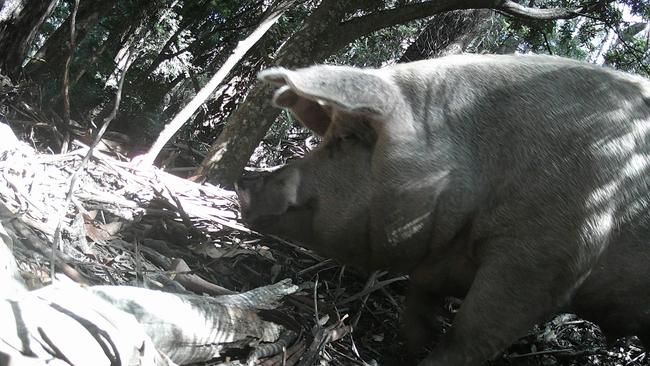Feral pigs terrifying communities, attacking animals and desecrating environment
Feral pigs are going hog wild in Tasmania, according to a land owner, who says their numbers are on the rise. Here’s why these pesky porkers are a problem.

Tasmania
Don't miss out on the headlines from Tasmania. Followed categories will be added to My News.
According to the state government the only population of feral pigs in Tasmania live on Flinders Island where they’ve been snuffling for close to 200 years.
But according to Tasmanians in a number of small communities such as Gunns Plains and Waratah, farmed-turned-feral pigs are roaming in increasing numbers; terrifying communities, attacking domestic animals and desecrating the environment.
Now, unconfirmed reports are emerging of a small colony of escaped farm pigs turning feral on the outskirts of Hobart.
When contacted for comment Biosecurity Tasmania said it had “no reports” from the public of pig escapes in the Hobart area.
Meanwhile in the North West, Gunns Plains land manager Jason, who wants to protect his identity in the small community, said the problem is getting worse, with one of his land plots of 60 hectares “savaged” by feral pigs, which also ate the entire population of giant freshwater lobsters in his waterways.

“In 2014 when I saw my first feral pig they probably impacted 20 per cent of my land,” Jason said, who has been tracking and monitoring the pigs’ spread using tree-mounted cameras that can also film at night.
“Now, they’ve impacted the entire understorey, it looks like someone has come through with a rotary hoe. And they can be aggressive, especially the boars with tusks and when piglets are around.”

Feral pigs pose a serious risk to the delicate Tasmanian ecosystem, scientists say, and are among the most destructive invasive species at work in mainland Australia, with more than 23 million pigs costing the Australian agricultural sector over $100m per annum.
“Feral pigs can be quite aggressive towards humans, especially the longer they are in the wild the less they are habituated to us,” said Dr Tiana Pirtle a conservation officer at the Invasive Species Council.
“They are big, strong and very intimidating animals - they are also omnivores, so they will eat other…animals.”

In Gunns Plains there have been anecdotal reports of feral pigs attacking dogs, people, and property, as well as scaring kids who come across them in the forest.
Feral pigs also host a number of serious diseases such as hand, foot and mouth and contaminate freshwater supplies with their effluent.
In good conditions pigs can breed “all year around and at a rapid rate, akin to rabbits” the Department of Natural Resources said on its website, with a six month old female pig capable of producing two litters of 4-10 piglets a year.
Currently the Department of Natural Resources and Environment Tasmania has no plans to introduce statewide control measures on feral pigs, an approach Professor Barry Brook, a specialist in Environmental Sustainability at the University of Tasmania, agrees with.
“We need a watching brief certainly, but it seems like Tasmania isn’t a particularly suitable environment for them,” Prof Brook said.
Prof Brook’s team have been “camera trapping” across the state for years and while roaming pigs do pop up, they’re nowhere near the numbers of cats, deer and other invasive species threatening Tasmania.
“People shouldn’t be worried about a pig lurking for them, you know, in a corner of the dark bush ready to attack them,” Prof Book said. “That’s not the way those animals behave.”
On Wednesday The Central Coast Council petitioned the state government for legislative reforms to “manage the environmental and economic risk posed by wild and nuisance pigs more effectively”, a move welcomed by Jason, who has now spent $36,000 on fencing to try and keep the feral pigs off his land.
“They’re spreading…in this area it’s not uncommon to see 50 pigs a week, while there used to be just a couple every now and then.”
More Coverage
Originally published as Feral pigs terrifying communities, attacking animals and desecrating environment




